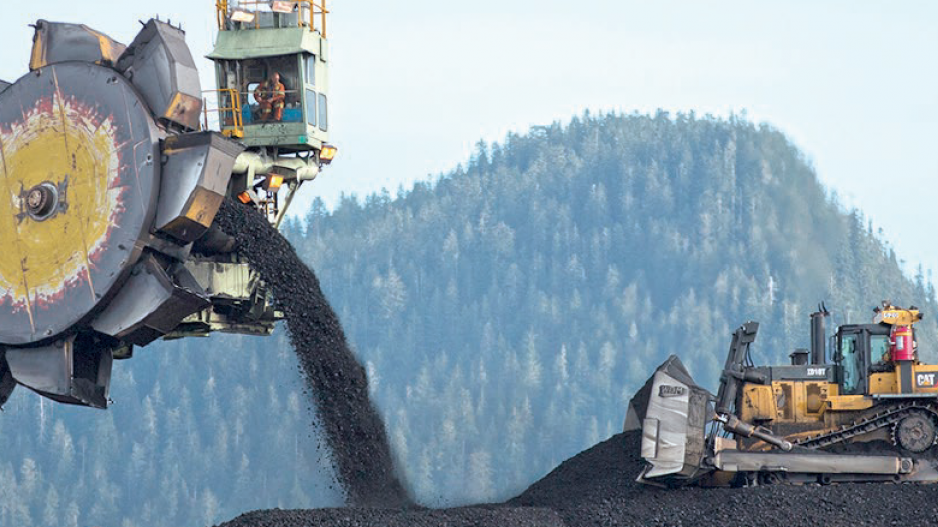As a market indicator, the most recent export figures from Prince Rupert Port Authority for B.C.’s metallurgical coal sector could not be more grim.
Shipments of steelmaking coal through Ridley Terminals fell 100%, to zero in July, according to the port’s July 2016 monthly snapshot. It was the first time since the annual July snapshots started being published in 2010 that no steelmaking coal passed through Prince Rupert in that month.
But a recent dramatic rally in metallurgical (met) coal prices and the acquisition of three idled coal mines in the Peace region suggest the sector may be turning a corner.
Steelmaking coal prices have shot up nearly 140% since the beginning of 2016, and earlier this month jumped a whopping 20% in the span of just one week.
Since spring, spot prices for met coal rose from US$90 per tonne to as high as US$180 per tonne.
“It jumped $20 in one day,” said Jim Truman, director of global metallurgical coal markets for Wood Mackenzie.
Robin Campbell, president of the Coal Association of Canada, said September 12, “If you talk to any analyst about the fact that coal increased 20% alone last week, nobody would have projected it.”
But the price spikes largely reflect supply-side issues, not global demand, which means that the market is being skewed by dramatic spikes that may obscure the long-term nature of the price recovery.
Some met coal has come off the market due to bad weather in Australia and China. China is also deliberately cutting its met coal production, although it’s unclear what Beijing’s long-term plans are for domestic coal production.
“We do see this as an anomaly,” Truman said. “It’s not going to go to $160 and then stay there. It’s going to drop back down to more reasonable levels, but there will be an increase.”
Metallurgical coal is B.C.’s third most important export, next to lumber and pulp and paper. Unlike thermal coal, it is used to make steel, not burned for power production.
In 2011, when coal came off the market in Australia due to mine flooding, metallurgical coal exports from B.C. represented nearly a quarter of the value of all exports from B.C. that year: $7.1 billion, or 22%, according to BC Stats. Coal exports have since fallen to just $3 billion in 2015 – just 8.6% of B.C.’s total exports.
A slowdown in demand from China for met coal and a global oversupply created a four-year-long price trough. Prices fell from more than US$300 per tonne in 2011 to below US$80 per tonne in 2015.
The glut and low prices forced a number of metallurgical coal mines to close – including four in B.C. – and forced several coal mining companies into bankruptcy, including Walter Energy, which shuttered three of its B.C. mines in the Tumbler Ridge-Chetwynd area between 2014 and 2015.
Anglo American PLC also shuttered a met coal mine in Tumbler Ridge in 2014. That left only one company still operating metallurgical coal mines in B.C. – Teck Resources (TSX:TCK.B).
The shuttering of Peace region coal mines explains why exports through Ridley Terminals in Prince Rupert fell to zero in July. Teck ships its coal through Lower Mainland ports, which had only a 4% decline in export volumes of met coal in the second quarter of 2016, compared with Q2 2015.
About half of Teck’s business is met coal, and the prolonged price drop has taken its toll on the company’s revenues and share prices. Its stock bottomed out in mid-January 2016, falling to just $3.80 per share, prompting the company to take a number of cost-cutting measures.
But the company managed to keep its five B.C. mines operating, and thanks to its belt-tightening and this year’s met coal price rally, Teck’s shares have also rallied, gaining roughly 500% since January to a recent high of $24 per share.
Last week, Morgan Stanley upgraded its Teck rating based on metallurgical coal prices.
“I think Teck has done a good job of weathering the storm,” Campbell said. “They’ve tightened where they had to. They continue to put out a good-quality product. Looking long term, I think they’ve taken the attitude that they’ll be in the game a long time and made the adjustments they had to continue to compete.”
Thanks to some of the mine closures, a global glut of met coal is being slowly whittled down. One big unanswered question for met coal producers is what China plans to do, both on the supply and demand side.
On one hand, it recently moved to cut production by reducing the days of operation at Chinese mines to 276 days from 330 days. On the other hand, Chinese producers recently signed an agreement to increase production, Truman said.
“So that would lower the import demand, and it would temper prices down,” Truman said.
“You don’t get a lot of information out of China,” Campbell said. “They’re looking at restructuring their whole industry. While the new prices on the spot market are welcome, I wouldn’t be holding my breath thinking this is going to be long term.”
India is now seen as the next significant market for steel and its key ingredients – iron ore and met coal.
As for the three idled mines in the Peace, Conuma Coal Resources Ltd. is buying them from Walter Energy. The company plans to restart the Brule mine near Chetwynd this week, and has plans to restart the Wolverine mine near Tumbler Ridge in 2017.
Meanwhile, Australian junior miner Atrum Coal NL (ASX:ATU) still plans to invest $600 million in a new anthracite coal mine 150 kilometres northeast of Stewart.•




